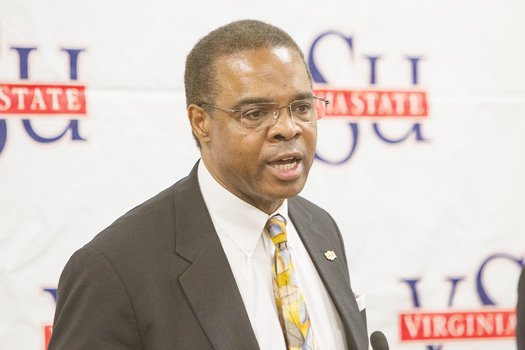Students protest VSU leadership
Jeremy M. Lazarus | 10/7/2014, 12:41 p.m.

Confidence in Dr. Keith T. Miller’s leadership as president of Virginia State University appears to be quickly eroding as the university deals with a serious financial challenge brought on by slumping enrollment.
This week, more than 200 students rallied on campus to call for the removal of Dr. Miller and two other high-ranking school officials as sharp cuts in classes and programs impact campus life.
“Time for a change” was one slogan on signs students displayed at the demonstration.
Behind the scenes, rumors are flying that the 15-member VSU board of visitors currently led by Harry Black, Richmond’s former chief financial officer and Cincinnati’s current city manager, are increasingly eager to see Dr. Miller move on.
Dr. Miller’s problem: A far steeper drop in enrollment than he had anticipated. Overall, the school has advised its board that 752 fewer students enrolled this year than in 2013.
That has translated into a loss to the school of millions of dollars in tuition, fees and payments for room and board.
And it has forced Dr. Miller into the unpleasant task of reducing spending on everything from academic programs to lawn mowing to close what is now a $19.5 million deficit, or 10.6 percent of the school’s 2014-15 budget.
Among other things, he has had to close dorms, shrink cafeteria services, cut classes, reduce or eliminate evening programs and keep at least 30 faculty positions vacant.
That also has made him unpopular among students. VSU senior Anthony Jackson gave voice to that opinion at Tuesday evening’s rally in blasting Dr. Miller and his administration for orchestrating cuts that Mr. Jackson said hit hardest “at the services that we, as students, pay for.”
“The school’s leadership does not have its pulse on the needs, values and well-being” of students, Mr. Jackson said, noting that Dr. Miller and his administration have “promoted solutions without seeking the input of students.”
Dr. Miller’s situation is not unusual. Colleges and universities across the country are wrestling with the financial impact from falling enrollments after two decades of growth. The result is often a backlash from students and faculty opposed to the changes caused by shrinking dollars.
Even without the student losses, VSU, like other state-supported schools, already was expecting to receive less state funding as the result of state revenue shortfalls.
Still, Dr. Miller seems to have contributed to the loss of trust by failing to communicate the pressing troubles to his board, sources said.
As late as the end of August after classes had begun, he and his administration were still downplaying the financial problem.
David Meadows, vice president of administration and finance, at that time was reporting to board members that the school was projecting a $5.3 million deficit and offering assurances that steps were being taken to deal with the shortfall, though he offered few specifics. At the time, he estimated that the school would see only a $1.6 million revenue decline from reduced enrollment and $3.7 million in reduced state revenue.
It wasn’t until last week that students and board members learned that VSU is facing a deficit nearly four times larger, requiring far deeper cuts. Even at that point, Dr. Miller did not fully share his program for spending cuts with students or most others at the school, several students who attended the rally told the Free Press. They said the lack of information was a main reason for the rally.
The information on the deficit came from an updated report that Mr. Meadows made to the board Sept. 25 detailing the grim situation.
His report showed that the deficit exploded in large part because the approved budget included a wild overestimate of the number of students expected to live in school dorms and apartments and eat in the school’s cafeterias this school year.
The budget estimated that 3,763 students would pay room and board during the 2014-15 school year, but only 2,786 students currently are doing so, or 977 fewer students. That overestimate created a $12.1 million reduction in budgeted revenues.
In his comments to the board, Mr. Meadows blamed tighter federal policies that have made it harder to get college loans. He told the board that up to 800 more students would be on campus if they or their parents had been able to qualify for $3.4 million in federal education loans. He said those students would have generated about $14 million in fresh revenue.
However, board sources said neither he nor Dr. Miller proposed solutions to replace the federal dollars, such as running a fundraising campaign or temporarily allowing students who made less than full payment to attend.






